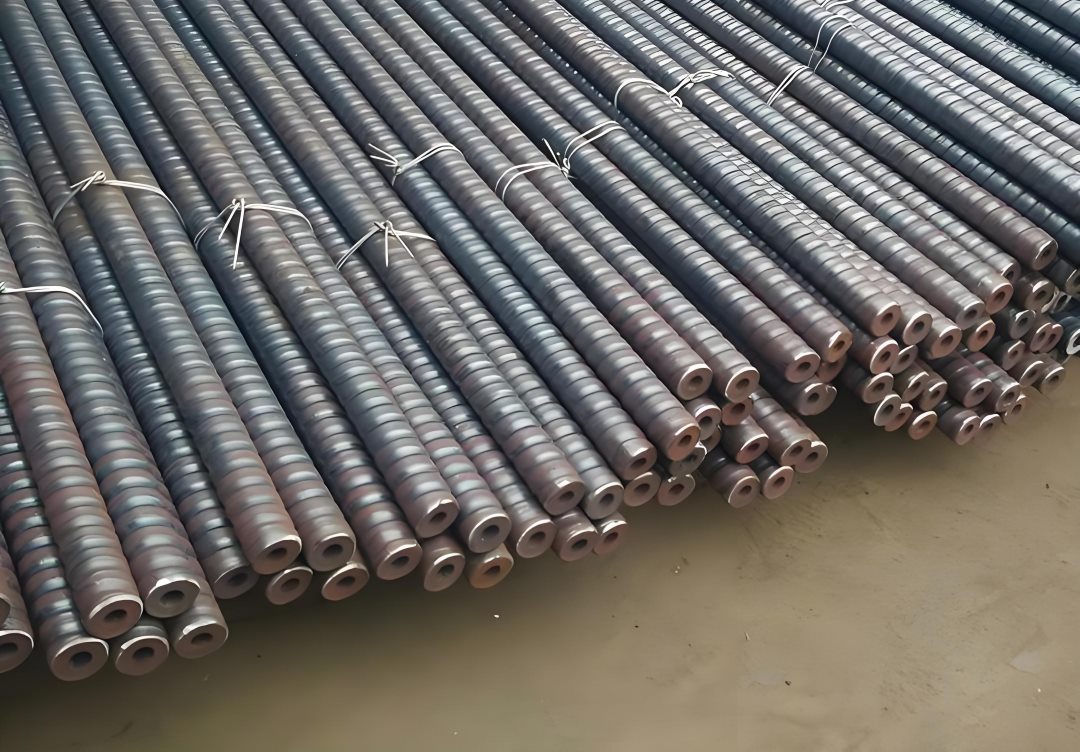A hollow grouting anchor is a new type of geotechnical support component that combines surrounding rock support with grouting reinforcement. Its core feature is a hollow channel within the anchor body, through which grout (such as cement slurry or cement-sand mortar) can be directly injected into the rock or soil surrounding the anchor, achieving simultaneous "support and reinforcement." It is widely used in underground or geotechnical engineering projects such as tunnels, slopes, foundation pits, and mines.

I. Core Components
The structural design of a hollow grouting anchor focuses on "grouting patency" and "anchoring reliability." It consists of five major components, each with a distinct function:
1. Hollow body: The main structure, bearing the supporting tension; the internal hollow channel is used to transport grouting. The surface of the anchor body is typically threaded (to enhance the bond with the grout/surrounding rock).
2. Grouting Joint: Connects the hollow rod to the grouting equipment (such as a grouting pump) to ensure sealed grout delivery and prevent leakage.
3. Grout Stopper: Installed near the hole mouth, it seals the gap between the drilled hole and the rod, forcing the grout to diffuse toward the hole bottom and into the surrounding rock fissures, ensuring full grouting.
4. Backing Plate: Transfers the anchor rod tension to the surrounding rock surface, increasing the load-bearing area and preventing the rod from crushing the surrounding rock.
5. Nut: Tighten and lock the backing plate, converting the anchor rod's anchoring force into a preload on the surrounding rock, improving the timeliness of support.
II. Working Principle: "Support + Grouting" Synergy
The operation of hollow grouting anchors can be divided into four key steps. The core is to improve the stability of the rock and soil by combining "grouting to reinforce the surrounding rock" with "active anchor support":
1. Drilling and Installation: First, drill a hole to the designed depth in the surrounding rock or soil. Insert the hollow anchor rod into the hole, and simultaneously install the grout plug, backing plate, and nut (not tightened yet).
2. Grouting: Connect the grouting pump to the hollow rod through the grouting joint, and pressurize grouting liquid into the hole. The grout flows through the hollow channel of the rod to the bottom of the hole, then reverses to fill the gap between the rod and the hole wall and penetrates into the cracks in the surrounding rock.
3. Grout Solidification and Anchoring: After solidification, the grout forms a "rod-grout" composite anchor with the hollow rod. It also cements cracks in the surrounding rock and fills pores in the soil, improving the strength of the surrounding rock (i.e., "grouting reinforcement").
4. Applying Preload: After the grout reaches the designed strength, tighten the nut and apply preload to the surrounding rock through the backing plate, allowing the anchor to actively restrain deformation and achieve a "support" effect.
III. Application Scenarios
Hollow grouting anchors are particularly suitable for weak, fractured, and fissured rock and soil. Common applications include:
① Tunnel Engineering: For initial support in highway/railway tunnels and subway tunnels (in conjunction with shotcrete and steel arches), reinforcing the surrounding rock behind the tunnel face to prevent collapse.
② Slope Engineering: For reinforcement of roadbed slopes, hydraulic slopes, and mining slopes, grouting is used to fill internal cracks in the slope to prevent landslides or collapses.
③ Foundation Pit Engineering: For vertical or horizontal support in deep foundation pits, especially in water-rich strata (the grouting can provide a certain water-stopping effect).
④ Mining projects: Support underground tunnels in coal and metal mines, reinforcing roof and side rock formations to ensure safe mining.
⑤ Underground structures: Support surrounding rock in underground pipeline corridors and civil air defense projects, improving the stability of the surrounding rock and soil.
IV. Performance Advantages (Compared to Traditional Solid Anchor Bolts)
Compared to traditional solid anchor bolts (such as ordinary threaded steel anchor bolts), the core advantage of hollow grouting anchor bolts lies in the added value of their grouting function:
1. Stronger Anchoring Strength: Grout fills the gap between the bolt body and the hole wall, eliminating the risk of "false anchoring" while simultaneously reinforcing the surrounding rock. This results in a 30%-50% increase in anchoring strength compared to traditional anchor bolts (depending on rock conditions).
2. Timelier Support: Grouting can be performed immediately after installation, allowing the grout to quickly solidify and provide temporary anchoring strength, making it suitable for rapid support needs in weak surrounding rock.
3. Adaptable to Complex Strata: Grouting can proactively repair soil and rock defects in fractured and cracked surrounding rock, whereas traditional anchor bolts rely solely on the bond between the bolt and the surrounding rock, which can easily fail.
4. Waterstopping: Using a cement-waterglass dual-liquid slurry (quick-setting slurry) can quickly seal seepage channels in water-rich strata, achieving both "support and waterstop" effects.
5. High Construction Efficiency: No additional grouting holes are required (the hollow channel within the bolt is utilized), simplifying the construction process and reducing work time.
Hollow grouting anchor bolts, through their "support and reinforcement" design, address the support challenges faced by traditional anchor bolts in weak and fractured strata, making them an indispensable component in modern geotechnical engineering.





